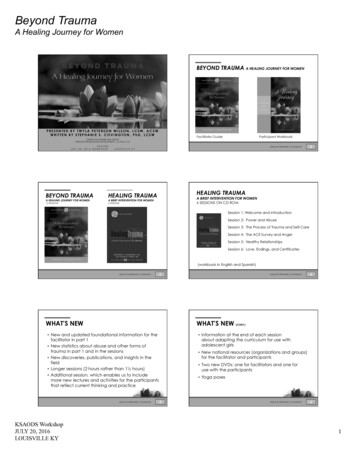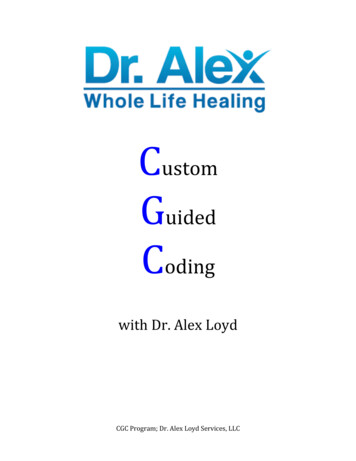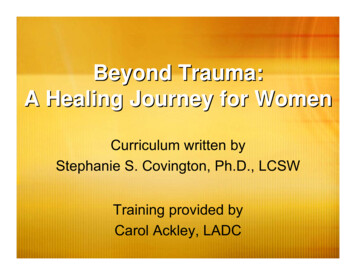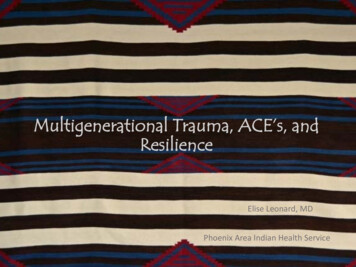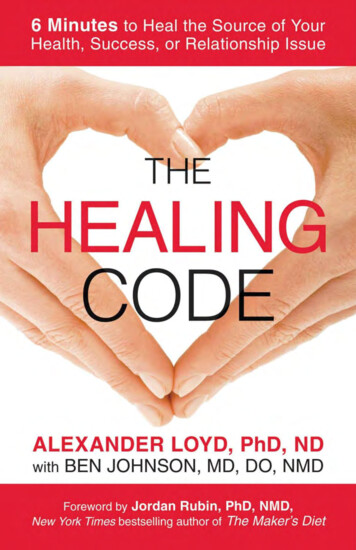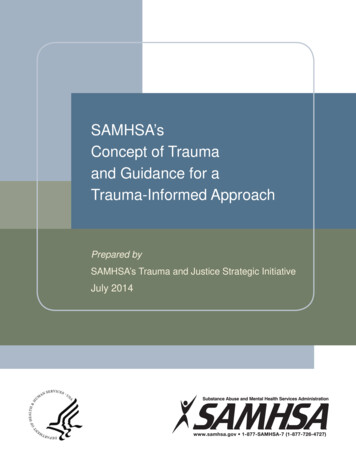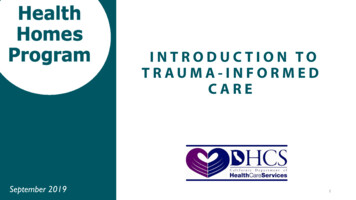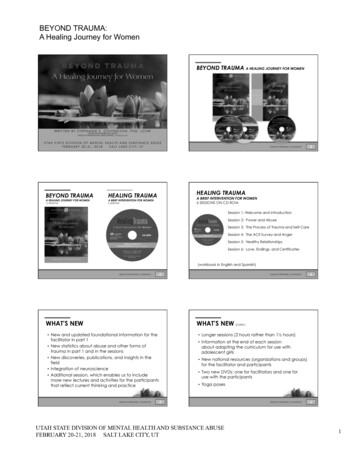
Transcription
BEYOND TRAUMA:A Healing Journey for WomenBEYOND TRAUMA A HEALING JOURNEY FOR WOMENP R E S E N T E D B Y T W Y L A P. W I L S O N , L C S WWRITTEN BY STEPHANIE S. COVINGTON, PhD, LCSWCENTER FOR GENDER AND JUSTICEINSTITUTE FOR RELATIONAL DEVELOPMENT LA JOLLA, CAU TA H S TAT E D I V I S I O N O F M E N TA L H E A L T H A N D S U B S TA N C E A B U S EFEBRUARY 20-21, 2018S A L T L A K E C I T Y, U TBEYOND TRAUMAHEALING TRAUMA12 SESSIONS6 SESSIONSA HEALING JOURNEY FOR WOMEN 2016 BY STEPHANIE S. COVINGTON2HEALING TRAUMAA BRIEF INTERVENTION FOR WOMEN6 SESSIONS ON CD-ROMA BRIEF INTERVENTION FOR WOMENSession 1: Welcome and IntroductionSession 2: Power and AbuseSession 3: The Process of Trauma and Self-CareSession 4: The ACE Survey and AngerSession 5: Healthy RelationshipsSession 6: Love, Endings, and Certificates(workbook in English and Spanish) 2016 BY STEPHANIE S. COVINGTON3WHAT’S NEW 2016 BY STEPHANIE S. COVINGTONWHAT’S NEW New and updated foundational information for thefacilitator in part 1 New statistics about abuse and other forms oftrauma in part 1 and in the sessions New discoveries, publications, and insights in thefield Integration of neuroscience Additional session, which enables us to includemore new lectures and activities for the participantsthat reflect current thinking and practice 2016 BY STEPHANIE S. COVINGTON4(CONT.) Longer sessions (2 hours rather than 1½ hours) Information at the end of each sessionabout adapting the curriculum for use withadolescent girls New national resources (organizations and groups)for the facilitator and participants Two new DVDs: one for facilitators and one foruse with the participants Yoga poses5UTAH STATE DIVISION OF MENTAL HEALTH AND SUBSTANCE ABUSEFEBRUARY 20-21, 2018 SALT LAKE CITY, UT 2016 BY STEPHANIE S. COVINGTON61
BEYOND TRAUMA:A Healing Journey for WomenPART 1:OVERVIEW OF TRAUMA AND THEBEYOND TRAUMA PROGRAMChapter 1: Background InformationChapter 2: Introduction to the ProgramPART 1:PART 2:OVERVIEW OF TRAUMA AND THEBEYOND TRAUMA PROGRAMSESSION OUTLINES 2016 BY STEPHANIE S. COVINGTON7CHAPTER 1: BACKGROUND INFORMATION 2016 BY STEPHANIE S. COVINGTON8CHAPTER 2: INTRODUCTION TO THE PROGRAM What Is Trauma? The Curriculum Women and Trauma Using the Facilitator Guide Understanding Trauma The Role of the Facilitator A Model for Women’s Recovery:Women’s Integrated Treatment (WIT) Suggestions for Conducting Group Sessions Working with Trauma 2016 BY STEPHANIE S. COVINGTON9 2016 BY STEPHANIE S. COVINGTON1011 2016 BY STEPHANIE S. COVINGTON12CHAPTER 1:BACKGROUND INFORMATION 2016 BY STEPHANIE S. COVINGTONUTAH STATE DIVISION OF MENTAL HEALTH AND SUBSTANCE ABUSEFEBRUARY 20-21, 2018 SALT LAKE CITY, UT2
BEYOND TRAUMA:A Healing Journey for WomenSTATISTICSLEVELS OF VIOLENCE ChildhoodThe following statistics illustrate howpervasive interpersonal violence is in thelives of women and girls. Adolescence Adulthood A woman is battered every 15-18 seconds (UnitedNations Commission on the Status of Women, 2000). Street (workplace and community) War Approximately 1.5 million women are raped orphysically assaulted by an intimate partner each year inthe US. Women under 24 years of age suffer the highestrates of rape (NOW, 2010). Planet There is one sexual assault every about every twominutes. (FBI CIUS, 2008). Consumer culture and media 2016 BY STEPHANIE S. COVINGTON13 S. Covington, Ph.D., 2009STATISTICSSTATISTICS 1 in 6 women will be sexually assaulted in herlifetime, with college age women 4 times more likelyto be sexually assaulted (RAINN, 2007). More than half of rapes occur before age 18 and22% occur before age 12 (CDC, 2009b). 1 in 5 girls and 1 in 10 boys are sexually victimizedbefore adulthood (Nat’l Center for Missing andExploited Children, 2008). In homes where DV occurs, children are seriouslyabused or neglected at a rate that is 1,500% higherthan the national average for the generalpopulation (Children’s Defense Fund Ohio, 2009). Children from violent homes have a highertendency to commit suicide, abuse drugs and/oralcohol, and commit violence against their ownpartners and children (Whitfield, Anda, Dube, andFelitti, 2003). More than 30 million children in the U.S. live in lowincome families, and 14 million children live inpoverty (Wight, Chau, and Aratani, 2010). Children born into poverty risk exposure to violencethat is so high they are guaranteed to be affectedby trauma (Women’s Law Project, 2002). S. Covington, Ph.D., 2009STATISTICS If a victim of domestic violence, a woman is 80%more likely to have a stroke, 70% more likely todrink heavily or to have a heart attack, 60% morelikely to have asthma (FVPF, 2009d). While relationship violence happens to women ofevery race and ethnic background, AfricanAmerican women are physically assaulted at arate that is 35% higher than Caucasian women,and about 2-1/2 times the rate of women ofother races. (National Coalition Against DomesticViolence, 2000).ECONOMICS Women in US earn 77% of what menearn African-American women earn .51on the dollar One-third of working women are thefamily breadwinnerVilleneuv, “Study Gives Details on Gender Pay Disparities”, S. Covington, 2015USA Today, 2012.UTAH STATE DIVISION OF MENTAL HEALTH AND SUBSTANCE ABUSEFEBRUARY 20-21, 2018 SALT LAKE CITY, UT3
BEYOND TRAUMA:A Healing Journey for WomenTWO KINDS OF SUFFERING NaturalAlthough the world is full of suffering,it is also full of the overcoming of it. Created Helen Keller 2016 BY STEPHANIE S. COVINGTON19 2016 BY STEPHANIE S. COVINGTON20DEFINITION OF TRAUMADEFINITION OF TRAUMAThe diagnostic manual used by mental healthThe exposure must result from one or more ofproviders defines trauma asthe following scenarios in which the individual directly experiences the traumatic event“exposure to actual or threatened death, witnesses the traumatic event in personserious injury, or sexual violence”(American Psychiatric Association 2013)DEFINITION OF TRAUMA 2016 BY STEPHANIE S. COVINGTON21the following scenarios, in which the individual learns that the traumatic event occurredto a close family member or close friend experiences firsthand repeated or extremeexposure to aversive details of the traumaticevent (not through media, pictures, television, or moviesunless work-related) 2016 BY STEPHANIE S. COVINGTON(American Psychiatric Association 2013)DEFINITION OF TRAUMA(CONT.)The exposure must result from 1 or more of(American Psychiatric Association 2013)(CONT.)23 2016 BY STEPHANIE S. COVINGTON22(CONT.)The disturbance, regardless of its trigger,causes significant distress or impairment in theindividual’s social interactions capacity to work other important areas of functioning(It is not the physiological result of another medical condition,medication, alcohol, or other drugs.)(American Psychiatric Association 2013)UTAH STATE DIVISION OF MENTAL HEALTH AND SUBSTANCE ABUSEFEBRUARY 20-21, 2018 SALT LAKE CITY, UT 2016 BY STEPHANIE S. COVINGTON244
BEYOND TRAUMA:A Healing Journey for WomenDEFINITION OF TRAUMAVIOLENCE AGAINST WOMEN(CONT.)Violence against women is so pervasive thatthe United Nations has addressed anddefined violence against women as “any actof gender-based violence that results in, or islikely to result in, physical, sexual orpsychological harm or suffering to women,including threats of such acts, coercion orarbitrary deprivation of liberty, whetheroccurring in public or in private life.”Trauma occurs when an external threatoverwhelms a person’s internal andexternal positive coping resources. 2016 BY STEPHANIE S. COVINGTON25TRAUMA(United Nations General Assembly 1993) 2016 BY STEPHANIE S. COVINGTON26GENDER AND ABUSE As children, boys and girls suffer similar rates ofabuse– Girls - sexually abused– Boys - emotional neglect or physical abuse. In adolescence, boys are at greater risk if they aregay, young men of color, or gang members.– Young men - people who dislike or hate them.– Young women – relationships; from the person towhom she is saying, “I love you.”Gender Differences 2016 BY STEPHANIE S. COVINGTONGENDER AND ABUSE27 2016 BY STEPHANIE S. COVINGTON28TRAUMATIC EVENTS(CONT.)Trauma can take many forms: Adulthood– Man – combat or being a victim of crimeexamples– Woman – relationship; the person “I love you.” Transgender– High risk and rates of abuse 2016 BY STEPHANIE S. COVINGTON29UTAH STATE DIVISION OF MENTAL HEALTH AND SUBSTANCE ABUSEFEBRUARY 20-21, 2018 SALT LAKE CITY, UT 2016 BY STEPHANIE S. COVINGTON305
BEYOND TRAUMA:A Healing Journey for WomenHISTORICAL TRAUMADEFINITION OF HISTORICAL TRAUMA Across generations“ the cumulative emotional andpsychological wounding spanninggenerations, which emanates from amassive group trauma.” Massive group trauma Examples include Native Americans,African Americans, Holocaust survivors,Japanese internment survivors 2016 BY STEPHANIE S. COVINGTON31INTERPERSONAL VIOLENCE 2016 BY STEPHANIE S. COVINGTON Take the trauma into account. Avoid triggering trauma reactions.Of all these forms of trauma,women are at greater risk of interpersonalabuse than men. Adjust the organization so that traumasurvivors can access and benefit fromservices.33CORE VALUES OFTRAUMA-INFORMED CARE(Harris and Fallot 2001) 2016 BY STEPHANIE S. COVINGTONSafety: TrustworthinessEnsuring physical andemotional safetyTrustworthiness:Maximizing trustworthiness,modeling openness,maintaining appropriateboundaries, and making tasksclearChoice:Emphasizing individualchoice and control Choice Collaboration Empowerment 2016 BY STEPHANIE S. COVINGTON34CORE VALUES OF TRAUMAINFORMED ENVIRONMENT Safety (physical and emotional)(Fallot and Harris 2008)32TRAUMA-INFORMED SERVICES(INTIMATE PARTNER VIOLENCE — IPV) 2016 BY STEPHANIE S. COVINGTON(Brave Heart 2005)35(Adapted from Fallot and Harris 2008)UTAH STATE DIVISION OF MENTAL HEALTH AND SUBSTANCE ABUSEFEBRUARY 20-21, 2018 SALT LAKE CITY, UT 2016 BY STEPHANIE S. COVINGTON366
BEYOND TRAUMA:A Healing Journey for WomenCORE VALUES OF TRAUMAINFORMED ENVIRONMENT(CONT.)Collaboration:Providing equality inparticipation, sharing power,and creating a sense ofbelongingEmpowerment:Striving for empowerment andskill-building(Adapted from Fallot and Harris 2008) 2016 BY STEPHANIE S. COVINGTONBecoming Trauma InformedCreates a Culture Shift37A CULTURE SHIFT: 2016 BY STEPHANIE S. COVINGTONPROCESS OF TRAUMASCOPE OF CHANGE IN A DISTRESSED SYSTEMTraumatic EventOverwhelms the physical and psychological coping skillsResponse to TraumaFight, flight, or freezeAltered state of consciousness, Body sensations, Numbing,Hypervigilance, Hyperarousal, Collapse Involves all aspects of program activities,setting, relationships, and atmosphere(more than implementing new services)Sensitized Nervous SystemChanges in the BrainBrain-Body Connection Involves all groups: administrators, supervisors,direct service staff, support staff, and consumers(more than service providers) Involves making trauma-informed changeinto a new routine, a new way of thinking andacting (more than new information)(Harris and Fallot 2001) 2016 BY STEPHANIE S. COVINGTONPROCESS OF TRAUMA38Psychological and Physical DistressCurrent stressors, Reminders of trauma (triggers)Sensations, Images, Behavior, Affect (emotions), MemoryEmotional and/or Physical ResponsesRetreatHarmfulBehavior to SelfHarmfulBehavior to OthersPhysicalHealth IssuesIsolationDissociationDepressive disordersAnxiety disordersSubstance use disordersFeeding and eatingdisordersDeliberate self-harmSuicidal actionsAggressionViolenceRagesThreatsLung diseaseHeart diseaseAutoimmune disordersObesity39 2016 BY STEPHANIE S. COVINGTONPROCESS OF TRAUMA(CONT.)40(CONT.)Psychological and Physical DistressCurrent stressors, Reminders of trauma (triggers)Sensations, Images, Behavior, Affect (emotions), MemoryTraumatic EventOverwhelms the physical and psychological coping skillsEmotional and/or Physical ResponsesResponse to TraumaFight, flight, or freezeAltered state of consciousness, Body sensations, Numbing,Hypervigilance, Hyperarousal, CollapseSensitized Nervous SystemChanges in the BrainBrain-Body Connection 2016 BY STEPHANIE S. COVINGTONRetreatHarmfulBehavior toSelfHarmfulBehavior toOthersPhysicalHealth ety disordersSubstance usedisordersFeeding andeating disordersDeliberate selfharmSuicidal actionsAggressionViolenceRagesThreatsLung diseaseHeart diseaseAutoimmunedisordersObesity41UTAH STATE DIVISION OF MENTAL HEALTH AND SUBSTANCE ABUSEFEBRUARY 20-21, 2018 SALT LAKE CITY, UT 2016 BY STEPHANIE S. COVINGTON427
BEYOND TRAUMA:A Healing Journey for WomenTRAUMATRAUMA(CONT.) Variation in what trauma is Acute event: accident, assault Variation in response Chronic: ongoing abuse, poverty, racism 2016 BY STEPHANIE S. COVINGTON43TOXIC STRESS 2016 BY STEPHANIE S. COVINGTON44PRIMARY RESPONSES Stress of adversity is toxic to thedevelopment of the brain Emotions—dysregulation Important consideration with children Relationships—lack of connection and trust 2016 BY STEPHANIE S. COVINGTON Behavior—unmanageable45 2016 BY STEPHANIE S. COVINGTON46PRIMARY ISSUES (CHILDREN) Attachment—relationships Regulation—feelings and behaviorTrauma Informed Competencies—learningTrauma Specific 2016 BY STEPHANIE S. COVINGTON47UTAH STATE DIVISION OF MENTAL HEALTH AND SUBSTANCE ABUSEFEBRUARY 20-21, 2018 SALT LAKE CITY, UT 2016 BY STEPHANIE S. COVINGTON488
BEYOND TRAUMA:A Healing Journey for WomenTRAUMA-SPECIFIC INTERVENTIONSTRAUMA: STAGES OF RECOVERYServices designed specifically to address violence, trauma, and relatedsymptoms and reactionsSYNDROMESTAGE ONESTAGE TWOSTAGE tExplorationof tationCombattraumaTrust, grationof trauma to facilitate recovery and healing 2016 BY STEPHANIE S. COVINGTONTRAUMA: STAGES OF RECOVERY49(Herman 1997)RECOVERYSTAGE ONERECOVERYSTAGE TWORECOVERYSTAGE THREETherapeutictaskSafetyRemembranceand ent, psSTAGE ONESTAGE TWOSTAGE bilization,communication,cooperationMetabolism oftraumaResolution,integration,development ofpost-resolutioncoping skillsTraumaticdisordersSafetyRemembranceand mourningReconnection 2016 BY STEPHANIE S. COVINGTONTRAUMA: THREE GROUP MODELSRECOVERYSTAGE ONERECOVERYSTAGE TWORECOVERYSTAGE BoundariesFlexible,inclusiveClosedStable, slowturnoverCohesionModerateVery highHigh(Herman 1997)51 2016 BY STEPHANIE S. COVINGTON(Herman 1997) 2016 BY STEPHANIE S. COVINGTONTRAUMA: THREE GROUP MODELS(CONT.)GROUP50TRAUMA: THREE GROUP MODELS(CONT.)SYNDROME(Herman 1997) 2016 BY STEPHANIE S. COVINGTON53(CONT.)RECOVERYSTAGE ONERECOVERYSTAGE TWORECOVERYSTAGE THREEConflicttoleranceLowLowHighTime limitOpen-endedor repeatingFixed ucturedExampleTwelve StepprogramsSurvivor groupInterpersonalpsychotherapygroupGROUP(Herman 1997)UTAH STATE DIVISION OF MENTAL HEALTH AND SUBSTANCE ABUSEFEBRUARY 20-21, 2018 SALT LAKE CITY, UT52 2016 BY STEPHANIE S. COVINGTON549
BEYOND TRAUMA:A Healing Journey for WomenKEY ELEMENTS (STAFF AND CLIENTS)TRAUMA AND ADDICTION Learn what trauma/abuse is Understand typical responsesThe women with more experiences oftrauma had more severe addiction issues. Develop coping skills 2016 BY STEPHANIE S. COVINGTON55ABUSE AND SUBSTANCE USE 2016 BY STEPHANIE S. COVINGTON57(McFarlane et al. 2005) 2016 BY STEPHANIE S. COVINGTON58POSTTRAUMATIC STRESS DISORDER (PTSD)Women who have histories of sexual assaultcommonly experience multiple factors: 65% experience PTSD 51% experience depression 82% develop anxiety 49% become dependent on alcohol 61% use illicit substances 44% experience thoughts of suicide 19% attempt suicide 2016 BY STEPHANIE S. COVINGTON56Women who experience more than 1sexual assault are 3.5 times more likely toeither start or increase the frequency oftheir substance use than women withonly 1 assault experience.SEXUAL ABUSE AND MENTAL HEALTH(Campbell, Dworkin, and Cabral 2009) 2016 BY STEPHANIE S. COVINGTONSEXUAL ABUSE AND SUBSTANCE USEAbuse within the first 5 years of lifeis significantly associated with substanceuse in girls as young as 12, through the teenyears, and in the early 20s.(Lansford, Dodge, Pettit, and Bates 2010)(Johnson, Cottler, O’Leary, and Abdallah 2010) Intrusive symptoms—flashbacks, nightmares,intense or prolonged distress Avoidant symptoms—avoiding people,places, and situations that are triggers orreminders; disconnection59(American Psychiatric Association 2013)UTAH STATE DIVISION OF MENTAL HEALTH AND SUBSTANCE ABUSEFEBRUARY 20-21, 2018 SALT LAKE CITY, UT 2016 BY STEPHANIE S. COVINGTON6010
BEYOND TRAUMA:A Healing Journey for WomenPOSTTRAUMATIC STRESS DISORDER (PTSD) (CONT.)POSTTRAUMATIC STRESS DISORDER (PTSD) (CONT.) Negative emotions and thoughts—blaming,excessive negativity, fear, anger, shame,diminished interests, feelings of isolation Arousal symptoms—angry outbursts, recklessand dangerous behavior, hypervigilance,difficulty sleeping(American Psychiatric Association 2013) 2016 BY STEPHANIE S. COVINGTON61TYPES OF ABUSETrauma seems to lead to brain changes ineveryone who is exposed. PTSD may notactually be abnormal or a “disorder” butthe brain’s natural reaction to events andexperiences that are abnormal.(Stark, Parsons, Van Hartevelt, et al. 2015)TYPES OF ABUSE 2016 BY STEPHANIE S. COVINGTON62(CONT.) Sexual abuseStigmatization Physical abuseWomen and girls in criminal justice system Emotional abuseWomen and girls of color Domestic violenceWomen and girls in poverty Witnessing abuse/violenceLesbian, transgender, bisexual women and girls Self-inflicted violenceWomen and girls with mental health disorders Military sexual assault (MST) 2016 BY STEPHANIE S. COVINGTON63 2016 BY STEPHANIE S. COVINGTONEFFECTS OF TRAUMAEFFECTS OF TRAUMANeuroscience research shows that the onlyway we can help women who haveexperienced trauma change how they feelis by helping them to become aware oftheir inner experiences and learn what isgoing on inside them.Most of our conscious brains arededicated to focusing on the outsideworld. Some of the activities in BeyondTrauma are designed to help womenfocus on the inside to identify and acceptthe emotions embedded in their bodies. 2016 BY STEPHANIE S. COVINGTON65UTAH STATE DIVISION OF MENTAL HEALTH AND SUBSTANCE ABUSEFEBRUARY 20-21, 2018 SALT LAKE CITY, UT64(CONT.) 2016 BY STEPHANIE S. COVINGTON6611
BEYOND TRAUMA:A Healing Journey for WomenEVOLVING TREATMENT APPROACHESGENDER-RESPONSIVE TREATMENT Creating an environment through– site selection– staff selection– program development– content and material that reflects an understanding of the realities ofthe lives of women and girls and addresses and responds to their strengthsand challenges.(Grella 2008) 2016 BY STEPHANIE S. COVINGTON67WHAT IS AGENDER-RESPONSIVE APPROACH? Women-only (WO) treatment compared tomixed-gender (MG) WO increased odds of successful outcomeby 49%69(Evans, Levin, Li, and Hser 2013) 2016 BY STEPHANIE S. COVINGTON70THEORETICAL FOUNDATIONThis model is holistic, integrated, andbased onThe theories related to gender andaddiction and/or trauma (and any otherrelevant treatment services) that create theframework of thought for programdevelopment. This is the knowledge basethat creates the foundation upon which theprogram is developed. the gender-responsive definition andguiding principles a theoretical foundation interventions/strategies that aremultidimensional 2016 BY STEPHANIE S. COVINGTON68LONG-TERM OUTCOMES (10-YEAR FOLLOW-UP)WOMEN’S INTEGRATED TREATMENT (WIT)(Covington 2007) 2016 BY STEPHANIE S. COVINGTONWOMEN-ONLY TREATMENTLess about differences between malesand females and more about usingresearch on girls and women (boys andmen) to guide what we do. 2016 BY STEPHANIE S. COVINGTON(Covington 2002)71UTAH STATE DIVISION OF MENTAL HEALTH AND SUBSTANCE ABUSEFEBRUARY 20-21, 2018 SALT LAKE CITY, UT 2016 BY STEPHANIE S. COVINGTON7212
BEYOND TRAUMA:A Healing Journey for WomenBEYOND TRAUMAWOMEN’S INTEGRATED TREATMENT (WIT)THEORETICAL FOUNDATIONA HEALING JOURNEY FOR WOMENTheory of AddictionHolistic health modelChronic neglect of self in favor of something orsomeone elseTrauma Theory– Sandra Bloom, MD– Judith Herman, MD– Peter Levine, PhD– Daniel Siegel, MDIntegrates cognitive-behavioral, expressivearts, guided imagery, and relational therapy.Theory of Women’s Psychological DevelopmentRelational-cultural model (Stone Center)Theory of TraumaThree-Stage Model (Herman)Upward Spiral—A Transformational Model (Covington) 2016 BY STEPHANIE S. COVINGTON73TREATMENT STRATEGIES 2016 BY STEPHANIE S. COVINGTONTREATMENT STRATEGIES74(CONT.) Cognitive-behavioralThe approaches used in the programthat create the therapeutic process.These are the ways in which theory isoperationalized (how theory is applied). Guided imagery Relational therapy Mindfulness Eye movement desensitization and reprocessing(EMDR) Emotional Freedom Techniques (EFT) Expressive arts Mind-body (yoga) 2016 BY STEPHANIE S. COVINGTON75BEYOND TRAUMAAND HEALING TRAUMA THEMES Safety Empowerment Mind-bodyconnection Connection(Aloneness) Woman-centered 2016 BY STEPHANIE S. COVINGTONEVIDENCE-BASED Substance abuse Normal reactions(Shame) 2016 BY STEPHANIE S. COVINGTON76Researched in Residential treatment Women’s prison Drug courtListed on NREPP and CEBC77UTAH STATE DIVISION OF MENTAL HEALTH AND SUBSTANCE ABUSEFEBRUARY 20-21, 2018 SALT LAKE CITY, UT 2016 BY STEPHANIE S. COVINGTON7813
BEYOND TRAUMA:A Healing Journey for WomenPRISON STUDY (NIDA FUNDED)CLIENT ASSESSMENT SCORES IMPROVEAFTER COMPLETION OF HWR AND BTMean Score 45 DaysHWRTOTAL 40-44BT Randomized control group Gender-responsive vs. Therapeuticcommunity Significant differences– Greater reduction of drug use– More likely to complete treatment– Remained longer in aftercare– Less recidivism (re-incarcerated) at 12 months(p .05 or less)Source: KIVA Program records – BDI & TSC Assessment, August 31, 2004 –October 13, 2006. Keaton, Curtis, and Burke (2006) SANDAG(p .05) S. Covington, 201579 2016 BY STEPHANIE S. COVINGTON80HEALING TRAUMADRUG STUDY (NIDA FUNDED)A BRIEF INTERVENTION FOR WOMEN6 SESSIONS ON CD-ROM Four sites in San Diego County Randomized control group Results– Fewer sanctions– Longer in treatment– Reduced PTSD symptoms– Judge notices differencesPRE AND POST TREATMENT FigureCHANGESIN SYMPTOMS OF4Changes in Symptoms of Depression and PTSD, CWC IPV Project,DEPRESSIONAND POSTTRAUMATIC STRESSOctober 1, 2012 through September 30, 2013 (N 53)2725Score2321CESD (t 4.79, df 52, p .000)PCL (t 2.96, df 52, p .005)191715Pre-Test 2016 BY STEPHANIE S. COVINGTON81Post-Test(September 2013 Annual Report: The Interpersonal Violence Project,Josephine M. Hawke, PhD) 2016 BY STEPHANIE S. COVINGTON82CHAPTER 2: INTRODUCTION TO THE PROGRAM The Curriculum Using the Facilitator Guide The Role of the Facilitator Suggestions for Conducting Group SessionsCHAPTER 2:INTRODUCTION TO THE PROGRAM 2016 BY STEPHANIE S. COVINGTON83UTAH STATE DIVISION OF MENTAL HEALTH AND SUBSTANCE ABUSEFEBRUARY 20-21, 2018 SALT LAKE CITY, UT 2016 BY STEPHANIE S. COVINGTON8414
BEYOND TRAUMA:A Healing Journey for WomenWHAT MAKES A GOOD FACILITATOR?WHAT MAKES A GOOD FACILITATOR? (CONT.)The following qualities in a facilitator will helpto ensure a positive group experience: Healthy boundaries, respects confidentiality Committed to and interested in women’sissues Trustworthy Credible Multicultural sensitivity and responsiveness Available Appropriate gender—a female shouldfacilitate the all-female groups Reliable, consistent Hopeful Prepares ahead of time for each session Warm, compassionate Emotionally mature 2016 BY STEPHANIE S. COVINGTON85 2016 BY STEPHANIE S. COVINGTON86WHEN IS SOMEONE READYTO EXPLORE TRAUMA?WHAT MAKES A GOOD FACILITATOR? (CONT.) If a trauma survivor, she needs to feelconfident that she is at a place in her ownrecovery that will allow for healthy andpositive outcomes for herself and thewomen in the group She is able to use some safe coping skills. She has no major current crises or instability(e.g., just became homeless). Content expertise, if possible She is willing to do this type of work. Skills as a facilitator She can reach out for help when in danger. She is not using substances to such a severedegree that emotionally upsetting workmay increase her use. 2016 BY STEPHANIE S. COVINGTON87WHEN IS SOMEONE READYTO EXPLORE TRAUMA? 2016 BY STEPHANIE S. COVINGTON88BEYOND TRAUMA(CONT.) Her suicidality has been evaluated andtaken into account.Each of the 12 sessions addresses how toadapt the session for adolescent girls. She is in an ongoing system of care that isstable and consistent, with no immediateplanned changes (e.g., discharge frominpatient unit or residential program). 2016 BY STEPHANIE S. COVINGTON89UTAH STATE DIVISION OF MENTAL HEALTH AND SUBSTANCE ABUSEFEBRUARY 20-21, 2018 SALT LAKE CITY, UT 2016 BY STEPHANIE S. COVINGTON9015
BEYOND TRAUMA:A Healing Journey for WomenGIRLS’ COMPARISON STUDYGIRLS’ COMPARISON STUDYSexually abused girls suffer more often fromthe following:(CONT.) Dropping out of high school at a higher rate Depression Major illnesses Dissociative symptoms Being diagnosed with a host of differentpsychiatric labels Troubled sexual development Obesity Self-harm(Trickett, Noll, and Putnam 2011) 2016 BY STEPHANIE S. COVINGTON91HEALING FROM TRAUMAHEALING FROM TRAUMA The physical symptoms of PTSD are withinmanageable limits. The woman has authority over her memories(that is, her memories don’t limit what she does;she chooses what to do, instead of beingimmobilized in some areas). The memory of trauma is linked with feelings. 2016 BY STEPHANIE S. COVINGTON93UPWARD SPIRAL(Adapted from Covington 1999, 2008)92(CONT.)(Harvey 1996, 2007) 2016 BY STEPHANIE S. tion) 2016 BY STEPHANIE S. COVINGTON Damaged self-esteem is restored (for example,a rape survivor realizes that the rape did notoccur because she was a “bad” woman). Important relationships have beenreestablished. The woman has reconstructed a system ofmeaning and belief that encompasses the storyof the trauma (for instance, she understandsthat the rape was not caused by her and thatsome men use power and control to get whatthey want). The woman is able to bear feelings associatedwith traumatic memories.(Harvey 1996, 2007)(Trickett, Noll, and Putnam 2011)Resilience is the ability to adapt well in theface of difficult life events. It is the ability torecover from or adjust easily to misfortuneor change.Healing(expansion) 2016 BY STEPHANIE S. COVINGTONThe word resilience stems from a Latinword meaning leap back.95UTAH STATE DIVISION OF MENTAL HEALTH AND SUBSTANCE ABUSEFEBRUARY 20-21, 2018 SALT LAKE CITY, UT 2016 BY STEPHANIE S. COVINGTON9616
BEYOND TRAUMA:A Healing Journey for WomenRESILIENCEPOSTTRAUMATIC GROWTH(CONT.)Although some people are more naturallyresilient, a way to develop resilience is inworking through the emotions and effectsof stress and painful events. Resiliencedevelops as people develop better copingskills. It also comes from supportive, caringrelationships with others. 2016 BY STEPHANIE S. COVINGTONPOSTTRAUMATIC GROWTH Positive changes from a major life crisis Searching for good in the terrible Beyond resilience Catalyst for higher level of functioning97 2016 BY STEPHANIE S. COVINGTON 2016 BY STEPHANIE S. COVINGTON98TRAINING(CONT.) Personal strengthVulnerability è powerlessness can paradoxicallyboost self-confidence RelationshipsBonding on a deeper level after tragedy Greater life appreciationCan shift perspective to focus on gratitude and joy BeliefsMay change or be reinforced by grief New possibilitiesPerceive new opportunities and pursue them(Calhoun and Tedeshchi 1999, 2013)(Calhoun and Tedeshchi 1999, 2013) Events across the country Onsite events Staff participating in program materials99 2016 BY STEPHANIE S. COVINGTON100BEYOND TRAUMAModule A Violence, Abuse, and TraumaModule BThe Impact of Trauma onWomen’s LivesModule C Healing from TraumaPART 2:SESSION OUTLINES 2016 BY STEPHANIE S. COVINGTON101UTAH STATE DIVISION OF MENTAL HEALTH AND SUBSTANCE ABUSEFEBRUARY 20-21, 2018 SALT LAKE CITY, UT 2016 BY STEPHANIE S. COVINGTON10217
BEYOND TRAUMA:A Healing Journey for WomenFORMAT FOR ALL SESSIONSBEYOND TRAUMA MODULE A:VIOLENCE, ABUSE, AND TRAUMA Quiet time—“settling” Check-in(11 activities) Review of between-sessions activitySession 1 Introduction to the Program DiscussionsSession 2 The Connections between Violence,Abuse, and Trauma LecturesSession 3 Power and Abuse Interactive exercisesSession 4 The Process of Trauma and Reactionsto Trauma Closing, grounding exercise 2016 BY STEPHANIE S. COVINGTON103BEYOND TRAUMA 2016 BY STEPHANIE S. COVINGTON104SESSION 1 ACTIVITIESMODULE A, SESSION 1Five SensesINTRODUCTION TO THE PROGRAMBreathing and ExhalingPalms Down, Palms UpGoal of the session: To introduce the program BeyondTrauma: A Healing Journey forWomen 2016 BY STEPHANIE S. COVINGTON105INTRODUCTIONS 2016 BY STEPHANIE S. COVINGTON106GOALS OF BEYOND TRAUMA Name To provide a safe place to reflect and learnmore about ourselves When and where you were born To learn about trauma and its effects onwomen How I identify myself People in my family One thing I like about myself or a special giftthat I have 2016 BY STEPHANIE S. COVINGTON To learn skills in dealing with trauma andtaking care of ourselves To identify the lives we want to live107UTAH STATE DIVISION OF MENTAL HEALTH AND SUBSTANCE ABUSEF
The following statistics illustrate how Childhood Adolescence Adulthood Street (workplace and community) . it is also full of the overcoming of it. Helen Keller 20 TWO KINDS OF SUFFERING Natural . emotional neglect or physical abuse. In adolescence, boys are at greater risk if they are


